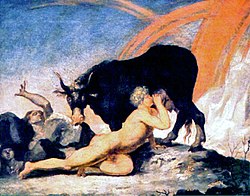 |
| Ymir,Auðumbla, Búri Nicolai Abildgaard (1790) |
Some authors associate Hathor with the Milky Way, while others imagine the Egyptians thought she was the sky itself (the House of Horus), or clouds (sky cows), thus her milk was life giving rain.
Our relationship with animals, except domestic pets, and with nature in general can be extremely attenuated, and for many people it's non-existent. It is possible to live within a completely man-made landscape, and indeed to only interact through the world via an electronic medium like TV or a computer or a phone.
| Deforestation in the US |
| Eurasian Steppe |
This is not a new phenomenon. Our ancient ancestors domesticated cattle sometime in the distant past. As new archaeological discoveries are made, the date moves back. Some researchers discovered evidence for cattle domestication in northeastern China as early as 10,000 years ago. It's noteworthy that this date is many thousand years later than the fusion of wolf packs and human tribes. [See articles on the co-evolution of dogs and people.] Cows are the domesticated descendants of wild (now extinct) Aurochs. Clearly, there's no divine cow myth without cows.
Researchers have speculated on a Proto-Indo European religion, which includes an Audumbla-like divine cow in it's canonical myths, but establishing dates or the origins of these stories is probably not practical. Depictions of Hathor date to the Fourth Dynasty in Egypt (2613 to 2494 BC), "only" 4,500 years ago so we're forced to wildly speculate.
Maybe the divine cow myth originates with those cows who first decided to live with people. It's not difficult to imagine processions of newly minted cows arriving in far flung settlements across the world. In ancient times, the arrival of a new handful of cattle to your village would have been as exciting as electricity was to people in 20th century America. They would have been celebrated, and glorious. They solve numerous problems (while creating numerous other ones). Cattle are a miraculous self-contained, self propelled, self-propagating industry that provides milk, cheese, meat, and leather.
We are completely removed, today, from the divinity of the cow and from what our relationship with her represents. When humans domesticated cattle and horses, they also domesticated themselves. Hopefully by meditating on these myths we can enliven what was lost.
No comments:
Post a Comment